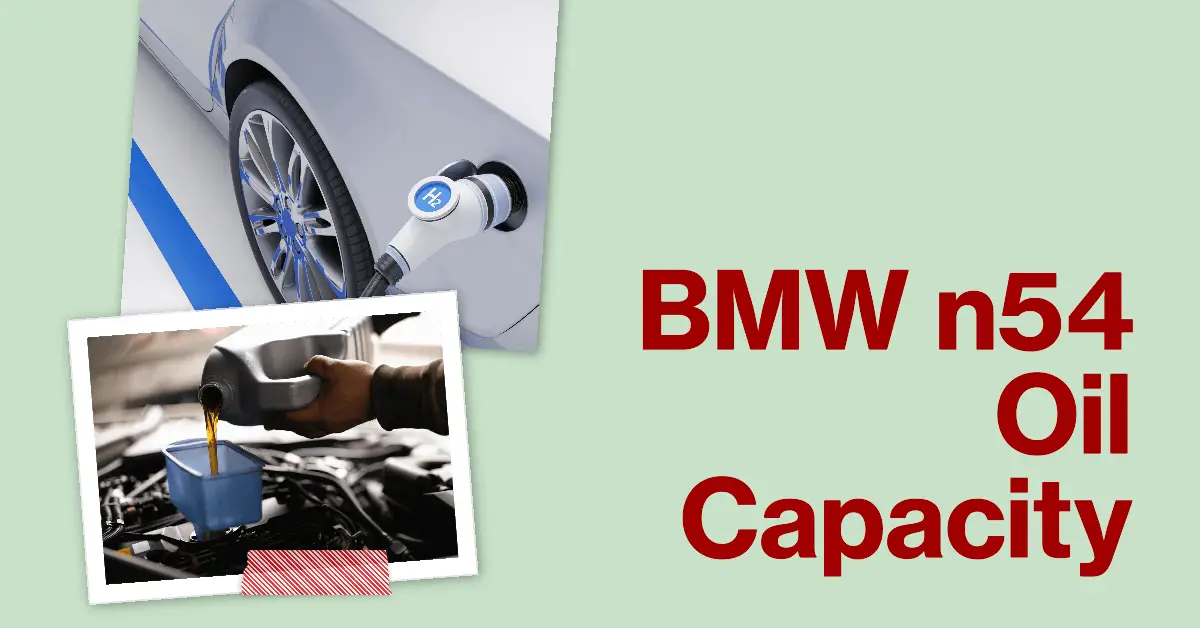N54 Oil Capacity: Everything You Need to Know
When it comes to properly maintaining your BMW N54 powered vehicle, understanding the correct oil capacity is absolutely crucial. Running your engine with the improper amount of oil can lead to lubrication issues, increased wear, and even complete engine failure in some cases.
So what is the proper oil capacity for N54 engines? The factory recommended oil capacity from BMW for stock, unmodified N54 engines is 8 quarts or 7 liters when doing an oil change with a new filter. This fills the oil to the proper level to keep your engine running smoothly without issues.
In this complete guide, we’ll cover everything BMW owners need to know about N54 oil capacity specs and maintenance best practices. You’ll learn about:
- Stock oil capacity and why it matters
- How to check your engine oil level
- Oil change intervals and procedures
- The impact of engine tuning on capacity
- Plus additional tips for keeping your N54 properly lubricated
Understanding these key details will help you avoid potentially costly mistakes and keep your BMW’s straight-six powerplant in peak operating condition. Let’s get started!
Why Proper Oil Capacity Matters
Oil is the lifeblood of any engine. It circulates throughout the engine to lubricate critical components and prevent excess friction and wear. The oil also contains additives that help clean contaminants, prevent corrosion, and absorb heat.
If oil levels fall too low, these vital lubricating and cooling functions become compromised. Running your N54 low on oil can quickly lead to increased component wear, overheating issues, audible timing chain rattle, and even complete engine failure in some cases.
On the flip side, overfilling your BMW’s oil beyond the recommended capacity can cause other problems. Too much oil in the crankcase pressurizes the seals and gaskets, leading to external oil leaks. The churning crankshaft can also whip up excess air bubbles in thicker, overfilled oil, reducing lubrication quality.
That’s why maintaining the proper 8 quart oil capacity specified by BMW is so important. This amount has been carefully engineered to deliver optimum lubrication and cooling for the N54’s moving components without overfilling the system.
Sticking to the recommended capacity will minimize engine friction and wear while also preventing messy leaks and other issues. Let’s look closer at the specs.
Stock N54 Oil Capacity
As mentioned above, the factory filled oil quantity with a new filter for N54 engines is 8 quarts or 7 liters.
This is the widely recommended oil fill level for stock engines under normal operating conditions. It applies to all N54 variants including the 335i, 535i, 135i, and Z4 35i models.
Some important notes on stock oil capacity:
- The capacity assumes a brand new OEM oil filter is being installed. Aftermarket filters vary in how much residual oil remains inside.
- Capacity may be slightly lower on higher mileage engines as components wear and tolerances loosen. A good rule of thumb is to add half a quart extra after 100k miles.
- Running low on oil is far more detrimental than slightly overfilling, so err on the side of adding an extra 1/4-1/2 quart if uncertain.
- Aftermarket oil coolers and extended oil pans found on some tuned cars also increase capacity. More on this later.
The takeaway is that 8 quarts remains the ideal N54 oil quantity for most engines under stock conditions when doing a complete oil change. Topping off between changes depends on current level, not total capacity. Next let’s go over the right way to check oil level.
Checking N54 Engine Oil Level
Since oil capacity gradually depletes between changes, the only way to accurately track proper fill levels is by regularly checking the dipstick. Here is the correct procedure:
Things You’ll Need:
- Clean rag
- Engine oil (verified correct viscosity)
Steps to Check Oil:
- Ensure vehicle is parked on level ground and has been idle at least 5 minutes, allowing oil to drain back to pan.
- Pop the hood and locate the engine oil dipstick near the back of the engine bay (yellow loop ring on black handle).
- Remove dipstick and wipe clean with the rag.
- Reinsert the dipstick fully until the handle bottoms out, then remove again.
- Examine the end of the dipstick to locate the oil level. Look for the holes punchmarked “min” and “max” indicating min/max fill range.
- Oil level should always be within min/max range and ideally closer to max. If oil is at or below min line, add 1 quart at a time, rechecking between each.
- Avoid overfilling past max line. Excess oil can cause leaks and oil aeration issues.
Checking level regularly (such as during each fuel fill-up) and topping up when required ensures you maintain the proper capacity. Never drive if oil level is at or below the minimum line on the dipstick.
Why Oil Changes are Critical?
While checking and topping off oil level maintains capacity between changes, regularly draining old contaminated oil is equally important.
Oil gradually degrades from heat cycles, fuel dilution, and suspended particles. The additives that make oil effective also deplete over time. Failure to complete full oil changes leaves this old oil in the engine and accelerates wear.
Here are some best practices for N54 oil changes:
- Change engine oil every 5,000-7,500 miles or as indicated by vehicle service message. Shorter intervals for track/performance driving.
- Always replace the oil filter to remove trapped particles and refresh its filtration capability. Use OEM or high-quality aftermarket filter.
- Use quality oil meeting BMW LL-01 spec in proper viscosity. Most areas can run 5W-30 year-round. See owners manual for alternate viscosities.
- Inspect drained oil for sludge, debris, or metallic particles indicating potential engine issues.
- Reset the vehicle service indicator or light after new oil and filter installed. This resets the reminder system.
- Dispose of old oil properly. Many shops and auto parts stores accept used oil for recycling.
Performing full synthetic oil changes at proper intervals keeps fresh oil circulating in your N54 while flushing out accumulating contaminants and spent additives. This prevents excessive engine wear and maintains peak performance.
How Engine Tuning Impacts Oil Capacity?
When modifying or tuning your N54 for more power, oil capacity requirements can change. Significantly increasing horsepower puts greater mechanical stress and heat loads on the engine, increasing oil demand.
Here are some ways engine tuning impacts oil:
- More boost pressure accelerates wear of internal components and seals which can raise oil consumption.
- Upgraded turbochargers create more bearing friction surfaces needing lubrication.
- ECU tunes advance timing which can raise combustion temperatures and oil breakdown rate.
- Adding bolt-on mods like intakes, intercoolers, and exhausts increase airflow needing oil cooling.
For these reasons, many choose to run 9-10 quarts of oil rather than stock 8 quarts in highly tuned N54 builds. This provides extra insurance against oil starvation issues under heavy modified engine loads.
Other oil system upgrades help maintain safe capacity margins:
- Adding external oil coolers or fins provides extra cooling and stabilizes viscosity.
- Switching to high-volume oil pans increases total system capacity.
- Using oil catch cans reduces blow-by gases in crankcase.
- Upgrading oil pump gears or dual pump systems optimize oil feed rates.
The best practice with built engines is to check oil very frequently when pushing limits and keep spare quarts on hand. Top off when oil nears minimum mark as tuned N54s consume oil at higher rates. Use thicker viscosity oil if within operating temperature range.
Maintaining safe oil capacity margins is cheap engine insurance when demanding more power from your N54.
Maintaining Proper N54 Oil Levels
To recap, here are the key steps for maintaining proper oil fill levels in your BMW N54:
- Use 8 quarts (7 liters) capacity for stock engine changes. Slightly more on high mileage engines.
- Check oil dipstick regularly and top up when nearing minimum mark.
- Change oil every 5-7k miles with new filter to flush contaminants.
- Consider 9-10 quart capacity for built engines making 500+ hp.
- Upgrade oiling system components on tuned engines as needed.
- Use quality oil meeting BMW LL-01 spec. Thicker viscosity oil if temperatures permit.
Remember, oil is the lifeblood of your engine. Take steps to properly maintain oil capacity and you’ll avoid unnecessary engine wear while keeping your N54 running smoothly for years to come. With these best practices, your BMW can continue delivering smiles per mile long into the future.
In Closing
We’ve covered everything BMW owners need to know about maintaining proper oil fill quantities in N54 powered vehicles. Understanding the factory recommended oil capacity and diligently checking/refilling oil is crucial to engine longevity.
Additionally, changing oil regularly and considering upgrades to oil cooling and capacity systems when modifying or tuning the engine will keep critical lubrication reliable.
By taking a proactive approach to monitoring and changing oil at proper intervals with quality lubricants, you can avoid costly engine issues down the road. Your N54 will hum along smoothly mile after mile, just as the BMW engineers intended.







